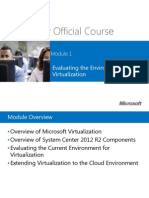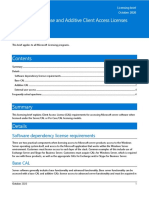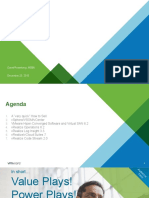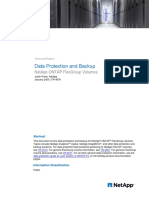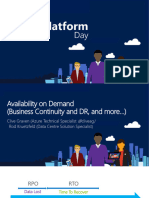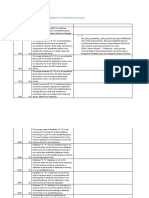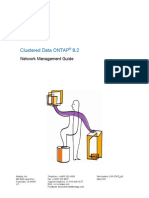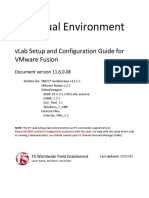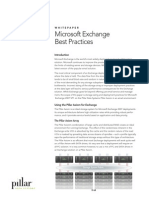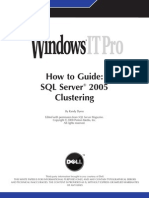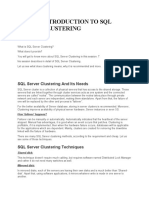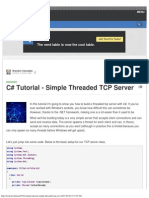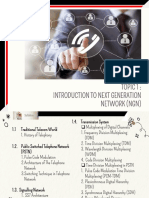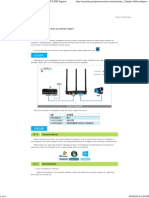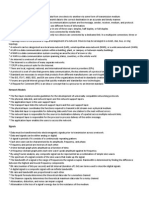Clustering SQL Server
By
Kareem Syed
www.optimizesql.blogspot.in
www.optimizesql.com/blog
SQLDBA
�Agenda
Understanding Windows Clustering
Working with SQL Clustering
Monitoring Clustering
Troubleshooting Clustering
www.optimizesql.com/blog
SQLDBA
�HA Overview
SQL Server High Availability
Goal of High Availability is to keep systems, applications, email,
databases etc always running
www.optimizesql.com/blog
3
SQLDBA
�Importance of HA
Server downtime is unavoidable.
But we have to keep the business running and competitive.
Server may go offline due to
Maintenance
Upgrade
Software or Hardware
Updates
Hot fixes, security patches
Accidently
Power Outages
Disasters
www.optimizesql.com/blog
4
SQLDBA
�Introduction to Clustering
Group of two or more servers (Nodes) that work
together and represent themselves as single Server
(Virtual Server) in the network.
A server cluster is a collection of servers, called nodes
that communicate with each other to make a set of
services highly available to clients.
Server clusters are designed for applications that have
long running in-memory state or frequently updated
data.
www.optimizesql.com/blog
SQLDBA
�Introduction
A Microsoft SQL Server Cluster is simply a collection of two or
more physical servers.
These Servers are called Nodes.
These nodes have same access to shared storage and
provides the resources required to store the database files
Each of the nodes talk to one another via a network
If one node does not communicate to the other node the other
node will take ownership of SQL Server service. This process
is called fail over.
A failover can occur both automatically (a server stops
communication for some reason) or manually.
www.optimizesql.com/blog
SQLDBA
�Basic Architecture
Client PCs
SQL Server
Server A
Virtual
Server
Server B
Heartbeat
Binn
Install
Upgrade
Cluster management
Shared
Disk Array
Hub
C,D
Hub
SQL Server
www.optimizesql.com/blog
Binn
Install
Upgrad
Backup
Data
FTData
Job, Log, repldata
SQLDBA
C,D
�Basic Architecture
Client PCs
SQL Server
Server A
Virtual
Server
Server B
Heartbeat
Cluster management
Shared
Disk Array
Hub
C,D
Hub
C,D
SQL Server
www.optimizesql.com/blog
SQLDBA
�Importance of HA
Feature
Database
Mirroring
Failover
Clustering
Log Shipping
Data Loss
No data loss
option
No data loss
Maybe
Failover
Automatic failover
option
Automatic failover
No
Failover time
seconds
~ 20+ seconds
Manual
Special
Hardware
No
Certified hardware
No
Redundancy
Complete
redundancy
Disks are shared
Complete redundancy
Multiple
Secondaries
No
No
Yes
Standby Read
Access
Yes, through
snapshot
No
Yes, WITH STANDBY
option
Granularity
Database
Instance
Database
Conn String
Two
ONE
Two
www.optimizesql.com/blog
SQLDBA
�Advantages
High Availability
Protection from failures
Server level hardware and software failures, service
failures etc
Site level Fires, earthquake etc
Online Administration
Software/hardware upgrades/patch and restart with minimal downtime.
Increased Scalability
In some cases, clustering can be used to increase the
scalability of an application. For example, if a current cluster is getting
too busy, another server could be added
to the cluster to expand the
resources and help boost the performance of the
application.
Clustering is transparent to the calling application.
www.optimizesql.com/blog
SQLDBA
10
�Advantages
Manageability
Enables managing resources within entire cluster if we are managing a
single computer.
Instance level redundancy and automatic failover for
SQL Server
www.optimizesql.com/blog
SQLDBA
11
�Advantages
Reduces downtime.
Allows for an automatic response to a failure in hardware/
software.
Allows you to perform upgrades without forcing users off the
system for extended periods of time.
Clustering doesnt require any servers to be renamed. So
when failover occurs, it is relatively transparent to end-users.
Failing back is relatively quick, and can be done whenever the
primary server is fixed and put back on-line.
In some cases, clustering can be used to increase the
scalability of an application. For example, if a current cluster is
getting too busy, another server could be added to the cluster
to expand the resources and help boost the performance of the
application
Clustering is transparent to the callingSQLDBA
application.
www.optimizesql.com/blog
12
�Disadvantages
Failover Cluster is NOT designed to:
Protect data
Protect against a shared disk array from failing.
Load Balance
Prevent server from potential data disasters.
Requires more on-going maintenance than other alternatives.
Requires more experienced DBAs and network
administrators.
www.optimizesql.com/blog
SQLDBA
13
�Disadvantages
This can be expensive.
Requires more set up time than other alternatives.
Requires more on-going maintenance than other alternatives.
Requires more experienced DBAs and network
administrators.
www.optimizesql.com/blog
SQLDBA
14
�What SQL Server services can we cluster?
Clusterable
SQL Server
SQL Server Agent
Analysis Services
Non Clusterable
SQL Server Integration Services
SQL Server Reporting Services
SQL Browser
SQL Writer
Full text search (FTS) service?
From SQL Server 2008, FTS service is integrated into SQL Server
engine
www.optimizesql.com/blog
SQLDBA
15
�Active and Passive
SQL Server offers Single Instance Clusters and Multi-Instance
Clusters.
Single Instance
Only one SQL Server Instance running at any given time on your
cluster. Itll be running either on your 1st node or 2nd node.
(Active-Passive).
Multi Instance
We have 2 nodes running 2 Instances or even 4 Instances of
SQL Server, Or lets say youve 3 nodes where youve 2
Instances of SQL Server(Active-Active-Passive), the third node
serving as a standby node ready to take ownership in an event
of any failure of Node1 or Node2.
www.optimizesql.com/blog
SQLDBA
16
�Basic Architecture
Virtual Name
Public Network
Node1
Active
SQL
Instance1
Heart Beat
Private Network
SAN
Shared Storage
Active/Passive Cluster
www.optimizesql.com/blog
SQLDBA
Node2
Passive
�Basic Architecture
Virtual Name
Public Network
Node1
Active
SQL
Instance1
Heart Beat
Private Network
SAN
Shared Storage
Active/Active Cluster
www.optimizesql.com/blog
SQLDBA
Node2
Active
SQL
Instance2
�Basic Components
A minimum of two identical servers.
Two NICs are needed per server.
Private, Public
Storage (optional)
Shared disk storage (SAN)
Quorum (Maintains cluster meta data) 256MB
MSDTC (Replication/Dist Trans)
SQL Server (Backup,FTData,data,repldata,log,job)
Tempdb
Data, T.Log Files
Distributed Transaction Coordinator (DTC)
Domain Controller.
Operating System, service or Application
www.optimizesql.com/blog
SQLDBA
�Failover Clustering
Terminology
SQL Server virtual server
It is cluster-configured resource group that contains all
resources necessary for SQL Server to operate on the
cluster. This includes
NetBIOS
Name of the virtual server,
TCP/IP address for the virtual server
All disk drives,
SQL Server services
www.optimizesql.com/blog
SQLDBA
20
�Failover Clustering
Terminology
Heartbeat
A single User Datagram Protocol (UDP) packet is sent
every 500 milliseconds between nodes in the cluster across
the internal private network,
This packet relays health information about the cluster
nodes as well as health information about the clustered
application
www.optimizesql.com/blog
SQLDBA
21
�Failover Clustering
Terminology
Failover
It is the process of one node in the cluster changing states
from offline to online.
It results in the node taking over responsibility of the SQL
Server virtual server.
The Cluster Service fails over a group in the event that node
becomes unavailable or one of the resources in the group
fails.
www.optimizesql.com/blog
SQLDBA
22
�Failover Clustering
Terminology
Failback
Failback is the process of moving a SQL Server virtual
server that failed over in the cluster back to the original
online node.
www.optimizesql.com/blog
SQLDBA
23
�Failover Clustering
Terminology
Quorum Resource
The quorum resource, also referred to as the witness disk in
Windows Server 2008.
It is the shared disk that holds the cluster servers
configuration information.
All servers must be able to contact the quorum resource to
become part of a SQL Server 2008 cluster
www.optimizesql.com/blog
SQLDBA
24
�Failover Clustering
Terminology
Resource Group
A collection of cluster resources such as the SQL Server
NetBIOS name, TCP/IP address, and the services belonging
to the SQL Server cluster.
A resource group also defines the items that fail over to
surviving nodes during failover.
Resource group is owned by only one node in the cluster at a
time.
www.optimizesql.com/blog
SQLDBA
25
�Failover Clustering
Terminology
LUNs
An LUN is used to identify a disk or a disk volume that is
presented to a host server or multiple hosts by the shared
storage device.
www.optimizesql.com/blog
SQLDBA
26
�Preparing Windows
Clustering
Pre installation checklist
Ensure that all nodes are working properly and are configured properly.
Confirm that each node can access shared array or SAN drives.
Verify that none of the nodes have been configured as domain controller.
Verify that all drives are NTFS and are not compressed.
Ensure that private and public networks are properly configured.
Verify that you have disabled NetBIOS for all private network cards.
Verify that Windows Task Scheduler service is running on each node.
Take a domain admin account for configuring windows cluster.
Use separate account for cluster service.
Add cluster service account to the Local Administrators group of all the
nodes in the cluster.
Decide windows cluster virtual name and virtual IP.
www.optimizesql.com/blog
SQLDBA
27
�Preparing Windows
Clustering
Pre installation checklist
Ensure that shared drives are available for the following
requirements
Quorum
MSDTC
TempDB
User Defined database data files
User Defined database T.Log files
Backups
www.optimizesql.com/blog
SQLDBA
28
�Preparing Windows
Clustering
IP Address Requirements
Name of Resource
IP Address
Private Network heartbeat (one per node)
Public Network (one per node)
MSDTC
Windows Cluster Name
SQL Cluster Name
www.optimizesql.com/blog
SQLDBA
29




